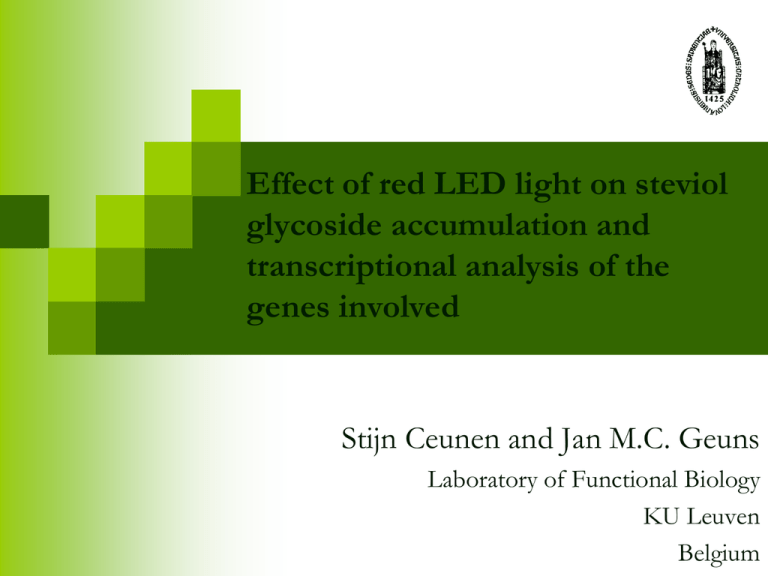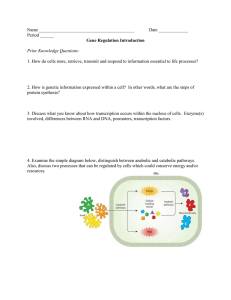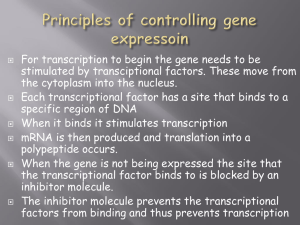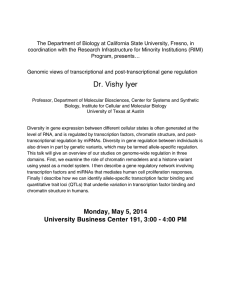Effect of red LED light on steviol glycoside accumulation and
advertisement

Effect of red LED light on steviol glycoside accumulation and transcriptional analysis of the genes involved Stijn Ceunen and Jan M.C. Geuns Laboratory of Functional Biology KU Leuven Belgium Contents Introduction Aim of the research Material and methods Results Plant development Spatio-temporal SVgly accumulation Transcriptional analysis Correlation dynamics Summary Acknowledgments 2/52 Introduction State of the art Stevia rebaudiana is a short-day plant (SD) SDs (< 12 h photoperiod) cause rapid flowering, contrary to long-days (LDs) During SDs, LD conditions are simulated with red LED light illumination during the night 3/52 4/52 5/52 6/52 Introduction State of the art 7/52 Week 25 8/52 Week 25 Week 32 9/52 Introduction SD Leaf dry SD + weight 5’ LED SD SVglys W9 W25 W35 2.3 g - - 3.5 g 34.2 g 130.8 g 0.05 g (2.0 %) - - 4.0 g (11.8 %) 14.5 g (11.0 %) SD + 0.15 g 5’ LED (4.3 %) 10/52 Introduction SD Leaf dry SD + weight 5’ LED SD SVglys W9 W25 W35 2.3 g - - 1 Year 13.3 g 15x 3.5 g 34.2 g 130.8 g 194.3 g 0.05 g (2.0 %) - - 0.3 g SD + 0.15 g 5’ LED (4.3 %) 4.0 g (11.8 %) 14.5 g (11.0 %) 74x 21.3 g 11/52 Introduction Practical application: simulating LDs on a field Belts of red LED lights Only 5 min illumination is sufficient Advantages Less harvests / year, thus less labour Low amounts of electricity needed (solar power!) LEDs have long lifespans (> 20,000 hours) Small investment per hectare (± 10,000 euro) Easier extraction due to greater percentage yield Temperate climate: at least two-month prolongation of growth season 12/52 Introduction Biosynthesis of SVglys 13/52 Introduction 14/52 Aim 15/52 Aim 1) Is there a physiological difference between plants grown under normal LDs and those under either LDs or SDs receiving red LED light? 2) How is the phytochrome effect reflected on the transcription of the genes involved in SVgly biosynthesis? 16/52 Material and methods Experimental set-up: preliminary test Mid-vegetative plants under LDs (16 h), with or without red LED illumination during the night Parameters: amount of flower buds and flowers, flowering rate 17/52 Material and methods Experimental set-up: main experiment Plant material: 180 in vitro propagated seedlings of similar morphology Conditions: LD (16 h photoperiod), SD (8 h) and SD (8 h) +5’ LED Sampling: leaves at nodes 3-4, 7-8, 11-12, 15-16 at different ontogenetic stages (determined by ontogeny under SDs) Parameters: SVglys* (Reb A, ST, Reb F, Reb C, Dul A, Reb G, Rub, Reb B, SB, SVE, SM), Reb A/ST, SV*, proteins*, gene transcription * Calculated per g dry matter 18/52 Material and methods Experimental set-up: main experiment Gene transcription RNA extraction (high purity only!) + cDNA synthesis Primers were based upon Mohamed et al. (2011) House-keeping genes: 18S rRNA and -actin qPCR analysis: GoTaq® qPCR Master Mix (Promega) Normalisation procedures according to 2−ΔΔCT method First normalisation against 18S rRNA or -actin Second normalisation against t0 (leaves at nodes 7-8 (upper leaves) of untreated, young vegetative plants) 19/52 Results Plant development 20/52 Results Preliminary test AVERAGE COUNTS LD Flower Flowering Flowers rate buds Total in 3 plants 289 115 40 % Per stem 32 13 40 % Total in 3 plants 153 25 16 % 17 3 16 % LD + 5’ LED Per stem 21/52 Results Main experiment SD 76 d from young vegetative stage to seed dispersal stage (12-13 nodes) LD and SD+LED After 76 d: still vegetative (17-18 nodes) No morphological differences 22/52 Results Spatio-temporal SVgly accumulation 23/52 Results 24/52 Results 25/52 Results 26/52 Results 27/52 Results 28/52 Results Transcriptional analysis 29/52 Introduction 30/52 Introduction 31/52 Results 32/52 Introduction 33/52 Results 34/52 Introduction 35/52 Results 36/52 Introduction 37/52 Results 38/52 Results Correlation dynamics 39/52 Results Gene transcription – product accumulation 40/52 Results 41/52 Results Gene 1 transcription – gene 2 transcription 42/52 Results Cultivar 1 – cultivar 2 43/52 Results Cultivar 1 – cultivar 2 44/52 Results Cultivar 1 – cultivar 2 45/52 Summary LD + LED causes further delay of flowering Plant morphology under SD + LED ~ LD % SVglys under SD + LED < LD (photosynthesis ↓) SD: sharp decline of % SVglys during flowering 46/52 Summary Reb A/ST ratio is stable under LD and SD+LED, but increases under SDs due to flowering (effect of ST ↓) Transcript levels: UGT74G1 > UGT85C2 > ent-KAH > UGT76G1 > ent-KS >> ent-KO Transcription ↓ during generative development under SD Note: transcription (HK) ↓, thus actual transcription (targets) ↓ LD and SD+LED: constant transcription 47/52 Summary Model Time Time 48/52 Summary Correlation dynamics No significant correlations between gene transcription and product accumulation Significant correlation between transcript levels of the different genes The variation of Reb A/ST ratio in leaves with different % SVgly content is cultivar-dependent, although the general profile remains: Smallest ratio: large, mid-stem leaves Greatest ratio: small, upper leaves (great % SVglys) or small, lower leaves (small % SVglys) 49/52 Acknowledgments Prof. Dr. Jan Geuns for supervising the research Shokoofeh Hajihashemi and Hilde Verlinden for the in vitro propagation of the Stevia plants Shokoofeh Hajihashemi and Sofie Deroover for help with the qPCR equipment Tom Struyf for helpful discussions 50/52 Thank you for your attention! Questions? 51/52



